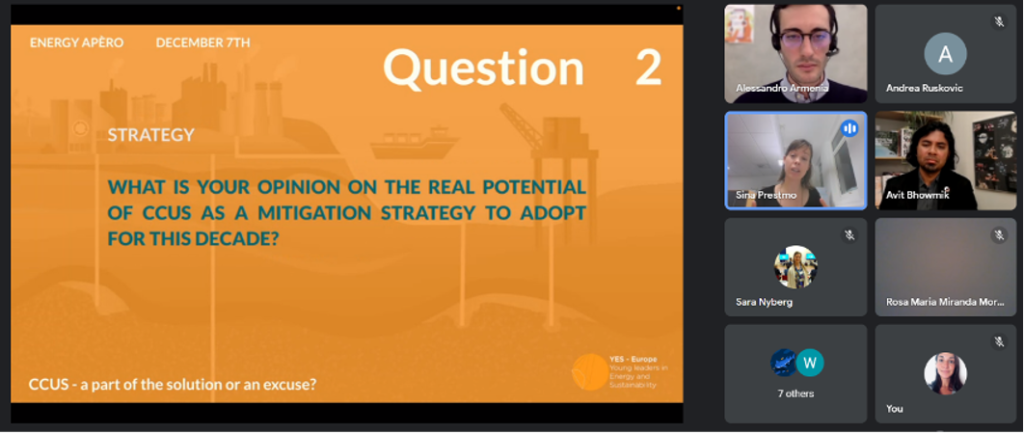On 7 December, the YES-Europe Policy team hosted the third edition of its Energy Apero Debate series. This time, the focus went on Carbon Capture Usage and Storage technologies. The event took place online, in the usual debate format, with a discussion guided by Alessandro Armenia, Policy Analyst from the YES-Europe Policy team. The topic of CCUS is not a new one, though a lot of uncertainty remains on its role in Europe’s decarbonization strategy. In December 2021, the Commission adopted a Communication on Sustainable Carbon Cycles, proposing, among other things, a framework to certify carbon removals. This proposal was officially adopted on 30 November 2022, with the intention of boosting innovative industrial carbon removal technologies. According to the International Energy Agency’s Sustainable Development Scenario, CCUS role to reach net zero targets will cover roughly 15% of the overall decrease in emissions.

The debaters involved were Sina Prestmo and Avit Bhowmik. Sina Prestmo is adviser at ECCSEL ERIC – The European Research Infrastructure Consortium for CCUS – and NTNU (Norwegian University of Science and Technology). Among her tasks as adviser in ECCSEL ERIC, Sina is also involved in the Horizon EU Research and Innovation funding and EU policy advisor. Dr. Avit Bhowmik is an environmental scientist, climate solutionist and sustainability strategist. Research Director of Centre for Research on Sustainable Societal Transformation and Assistant Professor of Risk and Environmental Studies at Karlstad University, Sweden. His current work focuses on exponential climate action and social tipping points for rapid climate mitigation and sustainability transformation.
While we stand by for the upcoming “strategic vision” for CCUS technologies expected in 2023, this debate was a great opportunity to hear from our two expert speakers what the pros and cons of this solution are. We asked the debaters: what is the perceived risk of CCUS investment distracting from proven climate solutions and increasing the extent of the carbon lock-in? Both Avit and Sina agreed that CCUS is a key solution to tackle the emissions of hard to abate sectors. “The current discussion has been around net zero, not emissions reduction”, was mentioned. In reality, modelling by the European Commission shows that the EU will need to capture and utilise or store between 300 and 640 million tonnes of CO2 every year by 2050 if it wants to meet its climate neutrality goal. Avit highlighted that there is a risk to putting too much hope on CCUS while the capacity is not yet available, priority should go into investment in renewables. He would instead prioritize support to R&D investments in CCUS, accompanied by a solid public debate. Sina on the other side believes in the importance of the EU taking leadership in CCUS deployment, enabled by an adequate regulatory framework. “We are at the beginning of journey”, she added.
When asked about the role of CCUS as mitigation strategy, Sina underlined that CCUS is an efficient way of mitigating emissions, especially considering that emission reductions on the utilisation part still has a long way to go. And while R&D is needed, actual results can only be achieved through implementation outside the lab. Avit counter argued that recent study shows that as the price of renewables is falling sharply, the value of CCUS as a mitigation tool drops as well.
Regarding the need for an EU Policy framework fit for purpose where it regards CCUS, Avit mentioned that EU policy is putting the emphasis on hard to abate sectors, and rightfully so. “Decarbonisation needs to happen now as fast as possible and we need to halve global emissions no later than 2030” he added. Furthermore, he supported we should put the focus on technologies that are scaling and available now, like renewables. Sina believes infrastructure is needed in order to implement CCUS across the EU and for that regulatory support is crucial. She added that there are expectations for the Commission to put forward a strategy for CCUS, which would be very welcome to bring clarity to the sector, as was done for hydrogen. When looking at the targets for 2030 it is important to differentiate across sectors. For some sectors there is no chance to decarbonize with current technologies (as the case of cement, a carbon intensive sector without solutions for emission abatement).
When asked about the ongoing lobbying from fossil fuel companies towards CCUS and the associated risk of Greenwashing, Sina clarified that provided that the existing energy storage bottlenecks are resolved, renewable energies will be able to make an even bigger contribution to decarbonisation and, considering the price reduction, the role of fossil fuels will reduce to the extent possible. And that is why in her opinion, long term there is no real danger that we will have more carbon emissions than absolutely needed. Avit added that the price of fossil fuels already has been proven to be a bad investment. While fossil fuel companies will try to hold on to CCUS to justify their continued operation, this will probably not go on for long. But when it comes to avoiding greenwashing, it remains important to release as much information as possible to society to allow citizens to make informed decisions and be part of the decision making on where to invest. Improving public acceptance, talk transparently about the technology is very important. Issues around security among others are also important to be addressed.

Leave A Comment